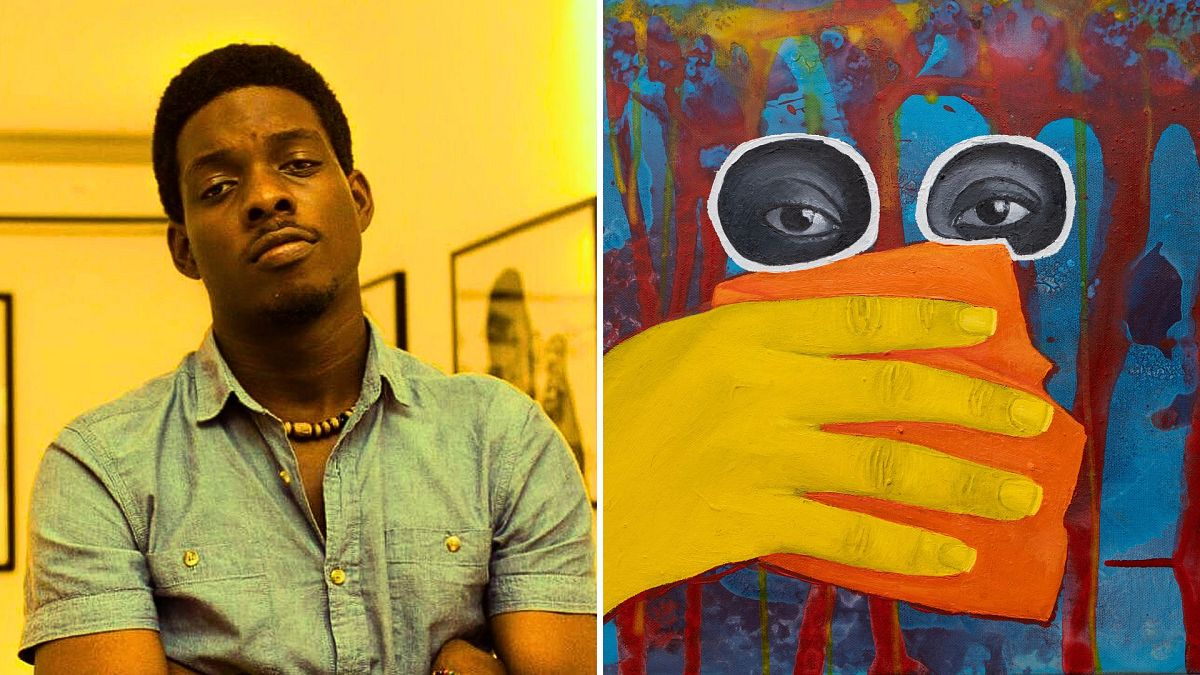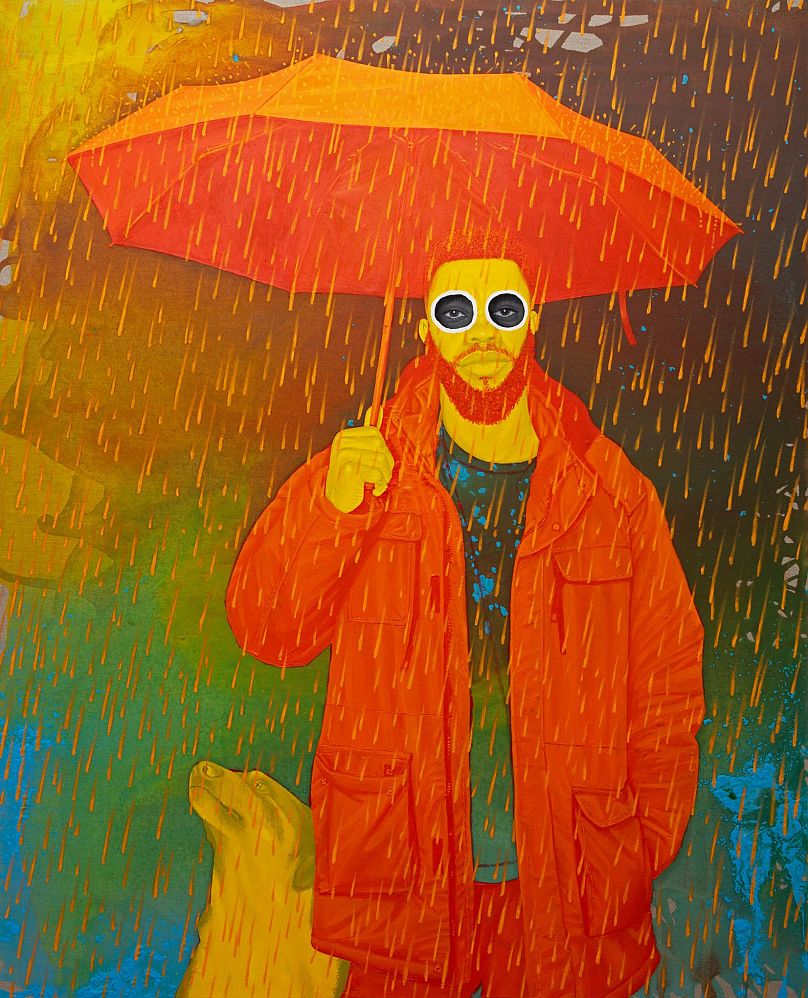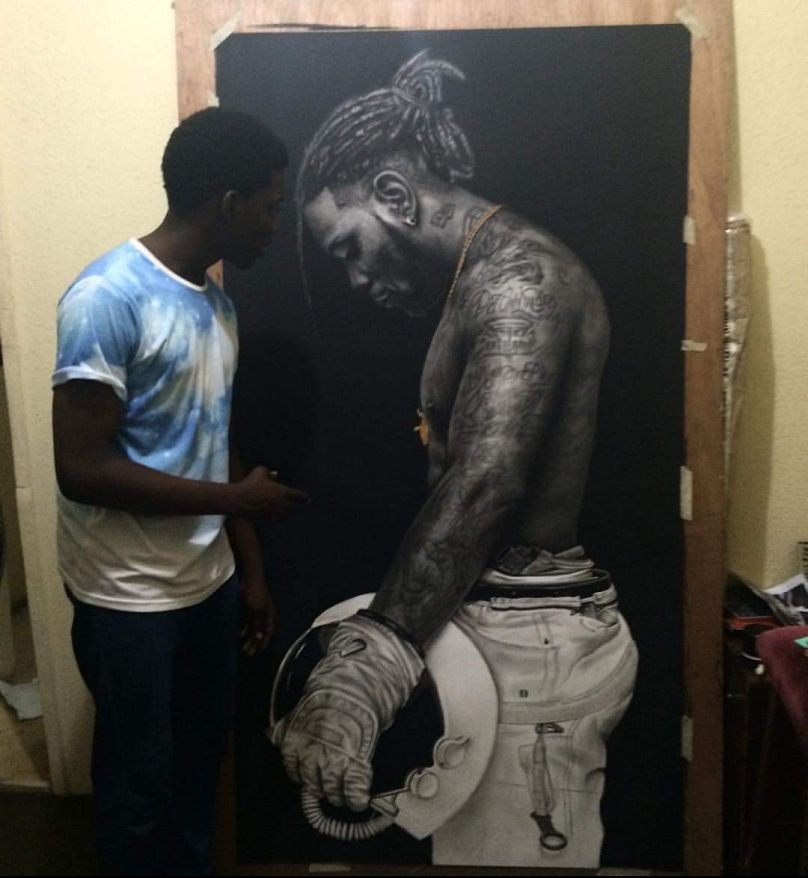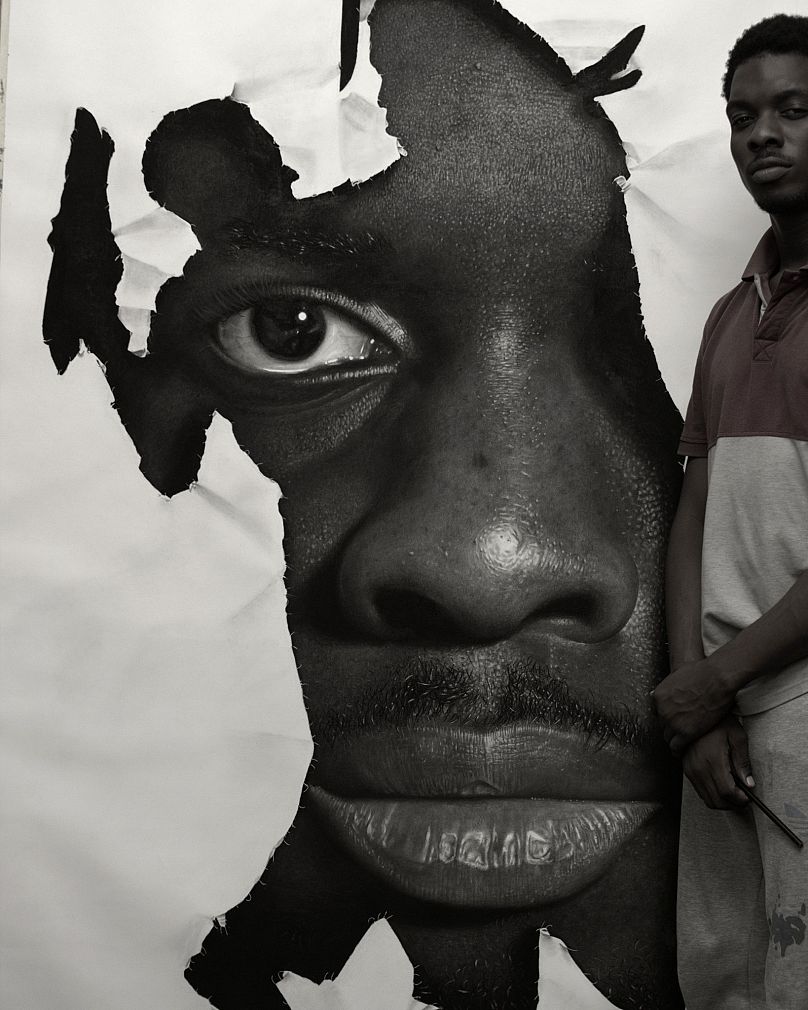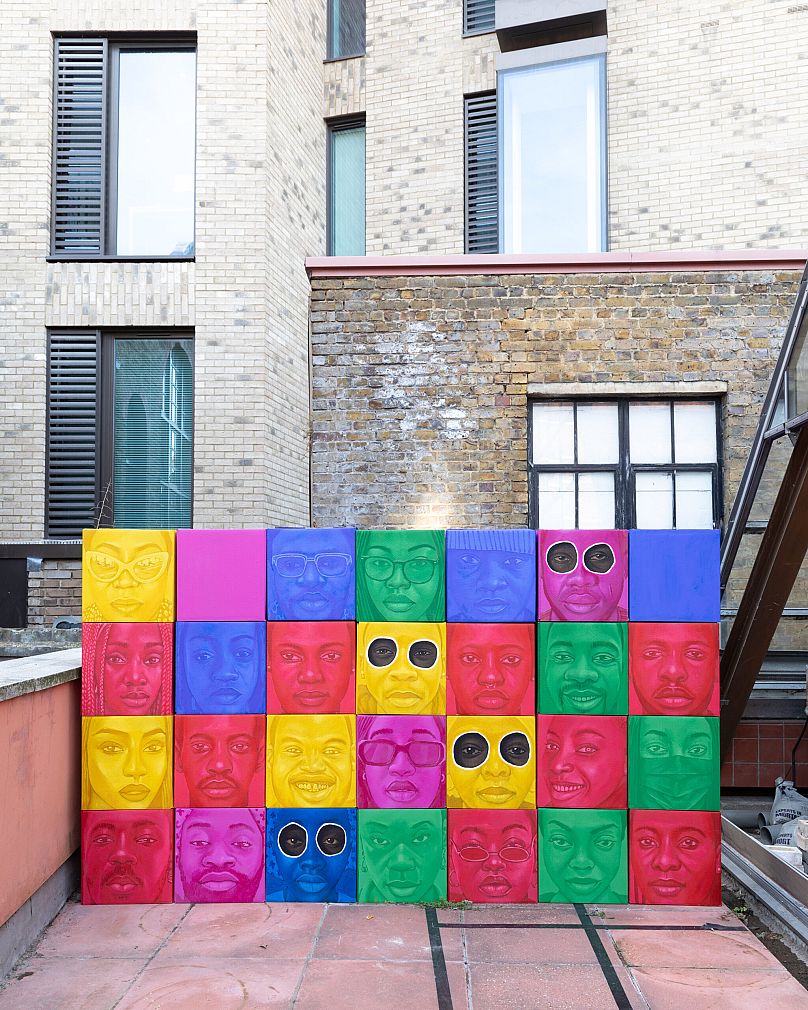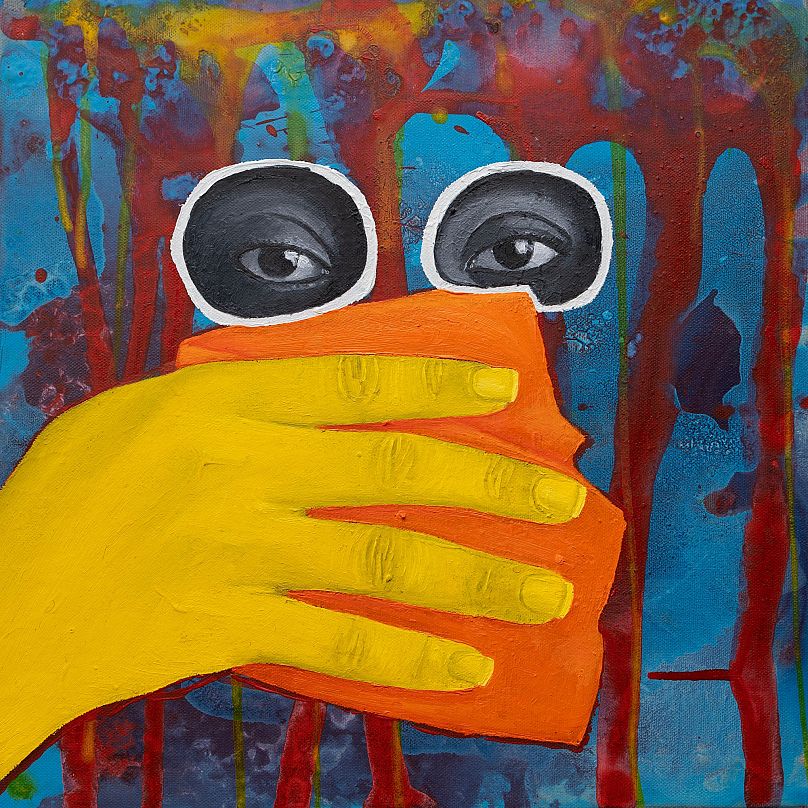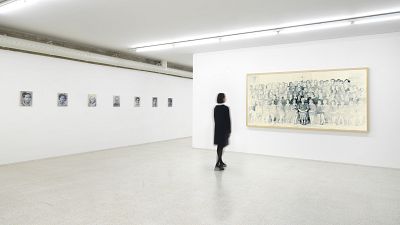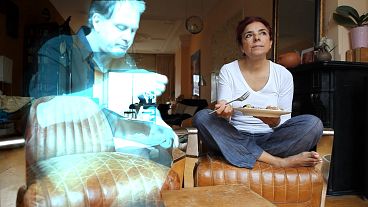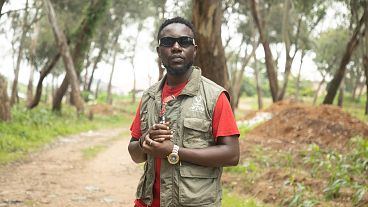Euronews Culture sat down with Ken Nwadiogbu, a visionary artist who is preparing to showcase his solo presentation 'Journey Mercies: A Migration Symphony' at ART SG later this month.
Back home in Nigeria, the notion of being a migrant never crossed the mind of 29-year-old multidisciplinary artist Ken Nwadiogbu.
It was only upon stepping beyond Africa's borders and moving to London, that the realisation struck – the awareness of being a Black man, an African man.
"There's this dehumanising mentality when people see an immigrant, which comes from the news, social media and new media talking about migration," shares Nwadiogbu with Euronews Culture.
"At this time, I see a huge conversation that can come from me being an immigrant. I want to lend my voice to that conversation - in a way to show people migration from my context. I want to change people's perception of how they see immigrants and how people see Africans moving from Africa to other parts of the world."
Known for infusing hyperrealism with a contemporary edge, and exploring themes of migration, Black identity and socio-political control, Nwadiogbu's trajectory into the world of art first took root in Lagos and has expanded globally.
He's created artwork for Afrobeats superstar Burna Boy, taken part in an exhibition for Netflix's final season of the hit show Top Boy, and soon will be presenting his work at ART SG, southeast Asia's leading international art fair (from 19 – 21 January 2024).
We met up with the joyful and laidback artist from his South London studio where he is currently working on his latest series, Journey Mercies: A Migration Symphony. Between sketching, painting and dancing to his tunes, Nwadiogbu opened up about his experience being a migrant in the UK, his artistic and creative process, and the current landscape of African representation in the art world.
Euronews Culture: How did your upbringing in Lagos influence the trajectory of your life, particularly in terms of your journey into the world of art?
Ken Nwadiogbu: In Lagos, if you're walking down the road you'd see artworks by incredible artists on the roadside. So, I think that was basically the earliest introduction I had with art. You'd see portrait drawings of people, celebrities and icons.
However, I didn't get into it until my undergraduate years as a civil engineer, where I saw this incredible guy drawing the dean of UNILAG at that time. It really sparked my interest - that somebody could create something so lifelike on paper with a pencil. It was incredibly mind blowing. And I wanted to do the same. So I took a pencil to some paper and the rest is history. I have been obsessed with it ever since.
Can you guide us through your creative process, starting from the inception of an idea? How do you go about transforming an initial concept into a tangible work?
Well, in the past, I used to have the whole idea in my head, before I even started working. All I needed to do was make sure that the idea and the execution were in alignment.
However, with my recent series, the approach has become more spontaneous. Before I start the work, I have no clue of what the artwork should be. I begin by pouring paint on the canvas, playing with abstract expression. I play music and dance all around the studio. This process forms the initial stage.
And then I start to go through my archives of pictures I've taken while in London, of immigrants and people like me. And as I go through all these images, I find a picture that resonates and decide that it's what I want to represent on canvas. Through this, the work begins to evolve, take shape and realise itself.
Where do you find your inspiration?
Everywhere. I could watch the news and see something that sparks my attention. It makes me want to bring my voice to the conversation. Then I start to think of ideas and how I can effectively express my own voice in the conversation. All of that process is very essential to how the work is realised.
But music as well. Music is a big inspiration. I play Burna Boy and Kendrick Lamar, and all of that sparks some form of inspiration inside of me. It makes me want to take paint to a canvas.
It's funny that you mention Burna Boy, considering you created the cover art for his 2015 album "On A Spaceship." Can you share your experience and emotions during that time, especially in having an artist of Burna Boy's stature choose your artwork?
Yeah, it was a really cool and interesting experience. And I think we even became friends. I'd basically go to his house and we'd speak about the artwork and go back and forth with ideas. He loved the finished work especially because it was so large and lifelike. It's funny because when it was published a lot of his fans just thought it was a photograph of him. But it was actually my work. He really opened so many doors for me and gave me some form of value. Working with someone who is now a Grammy Award winner, it was incredible.
There has been a huge surge in music and art emerging from Nigeria and the broader African continent. Did you get a chance to see Mr. Eazi's art project for his album 'Evil Genius'?
Yes, of course. He invited me for it. Beautiful, beautiful project. And it really shows you that many Nigerians are thinking outside the box. We're really exploring how we can fuse all of this cultural importance, all of this art and music, how we can merge them together to serve the same purpose in a way. And I think we're doing that. I think there's a huge space for Nigerian creatives.
Do you believe that Nigerian artists are currently receiving appropriate representation and recognition, or do you think there is still more work to be done within the art world?
There's definitely still more that can be done. But I can see the progress. Thanks to incredible artists like Victor Ehikhamenor, Nengi Omuku, so many incredible artists who have paved the way for us, they've brought African art to the global stage. Even incredible galleries like Retro Africa Gallery, that are working together, and collaborating together to push African art in that space. It helps us as artists to be able to tune in to that frequency and also be part of that conversation and be part of that journey that these people have started.
Hyperrealism appears to be one of the most prevalent art genres coming from the African scene. Why do you think it is particularly widespread among artists from the continent?
I think hyperrealism is everybody's first love. When you see a hyperrealistic work you just can't help but love it, right? It's like listening to good music. You don't need to explain the music. It's just good. It's incredible.
So for me, when I saw a hyperrealism for the first time while I was in UNILAG (University of Lagos), it just sparked something in me. And it's just that incredible feeling that something like that could happen from a simple, blank piece of paper. So in Africa I think it's just sparked everyone's attention and we all just love to create hyperrealism.
It's been a beautiful journey, honestly. It has built a real community. Arinze Stanley, Ayogu Kingsley, Oscar Ukonu, to name a few - we've all built a brotherhood. We share ideas and techniques, constantly striving to achieve the best representation of people in hyperrealistic art that we can.
The theme of migration in your work is very prominent and more relevant than ever. What inspired your focus on this topic?
Even if you were living under a rock, you'd still be able to recognise that migration is a crucial topic in our modern-day lives. I myself am a migrant. I stayed in Nigeria for quite a while - for 20 to 25 years of my life. Back home I never had the sense or the idea that I was a migrant, because I was home. The moment I stepped out of Nigeria, that's when I started to realise and see that I'm a Black person, that I'm an African man. And that's when migration became a very important theme for me.
I like to think about the way I am mentally, socially, politically, and address it, talk about it and bring it into my work. So at this time, I see a huge conversation that can come from me being an immigrant. I want to lend my voice to that conversation - in a way to show people migration from my context, from the perspective of people who look like me and also come from Nigeria.
What do you hope to convey through you work?
I want to convey the huddles, the restrictions, the politics and the issues that surround migration.
With the boxes that I did for my solo project 'Journey Mercies', it was all about representation and that immigrants are also people. We are people with items of value and we move and journey around. There's this dehumanising mentality when people see an immigrant, which comes from the news, social media and the new media talking about migration. I want to change people's perception of how they see immigrants and how people see Africans moving from Africa to other parts of the world.
But I also want to show the blessings that come from it as well, because migration in many ways has blessed the world.
Central to your artistic narrative are the eyes. Why do you choose to focus on them?
When you look at my personal history, you realise that the idea of eyes is deeply personal. When I was younger I almost lost an eye. I was playing with my brother and ran away from him because I pissed him off. But I ran into the handle of a door which pierced my eye and almost blinded me. My dad, who is a doctor, quickly rushed me to the hospital and did an operation and fixed it. But I couldn't see for a month with one eye.
And my mum always said "the eyes are the gateway to the soul." So when I paint, I contemplate how best to represent the essence of a subject, and every time, I choose the eyes. Through the eyes, I'm letting people see through the painting and see almost the soul of the character I'm trying to represent. It almost becomes a conversation you have with the painting because when you look at someone, eye to eye, there's an energy that flows in and it makes the person feels real.
How did you approach selecting colours for your new body of conceptual works?
For my abstract work I'm always trying to play with colours that are nostalgic to Africa, to my hometown. All of them are very vibrant. The red, the blue, the yellow, green. I want to look at it and feel like 'That feels like Nigeria. That feels like Ghana to me. That feels like South Africa to me'. They're very inspired by an incredible artist called Frank Bowling. I went to his studio while I was at the Royal College of Art. He uses these African, primary colours. And he just poured it on his canvas and I was very moved by it and wanted to try it myself in my own work.
My consideration of colour palettes also revolves around the idea that we are all energy. Everything that moves, everything we touch is energy. And so I aim to represent my reality as a form of energy that flows, incorporating memories that transform into energy which influence and alter my perception on life. These are memories from my experiences in London and have provided me insight into what it feels like being an immigrant in this country.
When you look at the work it kind of feels like the sun, doesn't it? It feels like heat. And in London, it's so cold that I need some form of heat in my life. These paintings give me heat and they give me the warmth that I need to continue to make my work.
Tell us about your upcoming showcase at ART Singapore
So it's called Journey Mercies: A Migration Symphony and it's all about migration. When you're travelling in Nigeria, your parents will say to you "journey mercies". It's basically a prayer for safe travel. Travelling is not easy and it takes a lot of energy. You need a lot of money and you have to navigate all the politics of it. The body of work should give you a glimpse or an idea of migration from my perspective.
For its first participation at ART SG, Retro Africa is delighted to present 'Journey Mercies: A Migration Symphony', a solo presentation of works by Ken Nwadiogbu from 19 – 21 January 2024.
